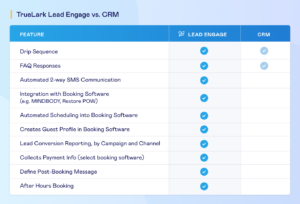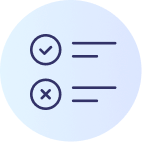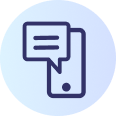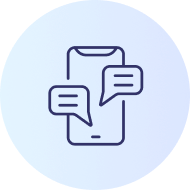In the pursuit of greater control over their leads, some businesses opt to replace AI-powered lead engagement tools with a CRM system. However, if the number one priority is lead conversion, the CRM may not be the best choice. In this blog post, we will explore why businesses may experience lower lead conversion rates when switching from AI-powered lead engagement tools to a CRM.
Why is AI-Led Lead Engagement Software Better for Conversions?
There are several reasons that when comparing the ability to convert digital leads, the AI-lead SMS engagement tool is usually a better choice. We’ll discuss the challenges of manual follow-up, the limitations of personalization and scalability, the capacity issues faced by staff members, and the impact of high employee churn on service consistency.
4 Good Reasons a CRM isn’t the Best Tool for Conversion
To be clear, we are not saying that a CRM isn’t a useful platform, we are simply comparing its ability to convert leads into booked appointments. The ideal scenario is to have SMS lead engagement tools integrated into a good CRM system for comprehensive lead and relationship nurturing. Let’s dive in.
1. Lack of Immediate and Personalized Follow-Up
One of the primary reasons for a drop in lead conversion rates when using a CRM instead of AI-powered lead engagement tools is the difficulty in providing immediate follow-up. With leads coming in at all hours, it becomes challenging for staff members to respond promptly, especially when multiple leads arrive simultaneously. Manual follow-up simply cannot match the speed and efficiency of AI-powered tools which can respond instantly to leads, ensuring timely engagement and a higher chance of conversion.
In this video, a TrueLark client explains how immediate lead follow-up boosted conversions: How a Wellness Business Achieved a 30% Lead Conversion Rate.
2. Lack of Personalization and Scalability
Manual follow-up through a CRM system often lacks the level of personalization and scalability offered by AI-powered lead engagement tools. AI-powered SMS engagement tools utilize Artificial Intelligence to follow-up and engage in two-way texting with leads, allowing for highly personalized and tailored interactions. On the other hand, manual follow-up requires staff members to manually input and update customer information, making it challenging to provide the same level of personalized engagement consistently. Additionally, as the volume of leads increases, manual follow-up becomes increasingly time-consuming and inefficient, limiting scalability and hindering lead conversion rates.
3. Capacity Constraints and Quality of Service
For businesses handling a high volume of leads, relying solely on manual follow-up can lead to capacity issues. Staff members may struggle to handle the influx of leads effectively without sacrificing the quality of service provided. With AI-powered lead engagement tools, businesses can automate and streamline lead engagement processes, ensuring every lead is promptly attended to. The automation capabilities enable efficient lead management, allowing staff members to focus on delivering exceptional service for in-person interactions.
4. Impact of High Employee Churn
Businesses with a high rate of employee turnover face an additional challenge when relying solely on manual follow-up. Training new employees to handle lead engagement can be time-consuming and disruptive to service consistency. AI-powered lead engagement tools offer a solution by providing consistent and automated lead engagement, regardless of staff turnover. Even during transitional periods, businesses can maintain a high level of service and seamless lead conversion with minimal disruption.
TrueLark Lead Engage vs CRM for Conversions
TrueLark Lead Engage is an add-on to our Virtual Receptionist. Both TrueLark Lead Engage and a CRM (Customer Relationship Management) system can be used to manage customer interactions, but the primary purposes are different. Lead Engage is designed to achieve the highest conversion rates possible, though it performs many CRM functions.
A CRM system typically focuses on managing customer data, such as contact information, buying history, and communication preferences, to help businesses improve their customer service and sales processes. A CRM is best equipped to handle these important functions.
TrueLark Lead Engage uses conversational AI to automate personalized and immediate conversations with leads. Advanced AI and a high level of automation allows Lead Engage to achieve an impressive lead conversion rate. Compare the features of TrueLark Lead Engage and a CRM:

Lead Conversion Rates: Check the Numbers
TrueLark Lead Engage sends an immediate text and then two follow-up messages to leads. Across one of our largest client groups (200+ locations) we are seeing an 18%-22% conversion rate with 90% booking an appointment in the first message.
Final Thoughts
While a CRM may offer a perceived sense of greater control over leads, it’s important to consider the potential drawbacks that can impact lead conversion rates. Manual follow-up lacks the speed, personalization, scalability, and efficiency provided by AI-powered lead engagement tools like TrueLark Lead Engage. Businesses should carefully evaluate their lead engagement strategies and prioritize tools that combine automation, personalization, and scalability to maximize lead conversion rates. In an ideal world, a small business can leverage the power of a lead engagement platform integrated with a CRM to streamline both lead nurturing and relationship management.
Want to see how TrueLark Lead Engage works? Schedule a demo today.




















